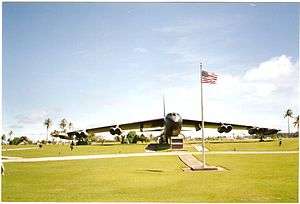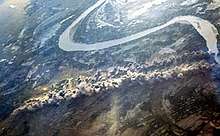Operation Arc Light

During Operation Arc Light (Arc Light, and sometimes Arclight) from 1965 to 1973, the United States deployed B-52F Stratofortresses from bases in the US to Guam to provide close air support to ground combat operations in Vietnam.[1] The conventional bombing campaign was supported by ground-control-radar detachments of the 1st Combat Evaluation Group (1CEVG) in Operation Combat Skyspot. Arc Light operations usually targeted enemy base camps, troops concentrations, and supply lines.
Aircraft used
Previously dedicated to carrying nuclear weapons, in 1964 the U.S. Air Force began to train strategic bomber crews to deliver conventional munitions flying the B-52F.
The B-52Fs were deployed to Andersen Air Force Base in Guam and U-Tapao Royal Thai Navy Airfield in Thailand. To add conventional bomb capacity, Project Big Belly modified all B-52Ds to enable them to carry 30 tons of conventional bombs.
By the middle of April 1966, all B-52Fs were redeployed back to the US and were replaced by the Big Belly modified B-52D. Later in the Vietnam War, the B-52G was also deployed with the B-52D.[2]
Operations in Laos and Cambodia
Congressional investigations of secret CIA activities in Laos revealed that B-52s were used to systematically bomb targets within Laos and Cambodia.
Operational use
The bombers were first used in Southeast Asia on June 18, 1965. Flying out of Andersen Air Force Base, Guam, twenty-seven aircraft dropped 750 pounds (340 kg) and 1,000 pounds (450 kg) bombs on a Viet Cong stronghold.[2] During this mission two B-52Fs were lost in a mid-air collision; another was lost when it was unable to conduct air refueling.
Missions were commonly flown in three-plane formations known as "cells". Releasing their bombs from high in the stratosphere, the B-52s could neither be seen or heard from the ground. B-52s were instrumental in wiping out enemy concentrations besieging Khe Sanh in 1968,[2] and in 1972 at An Loc and Kontum.

Arc Light was re-activated at Andersen on February 8, 1972 when President Richard Nixon resumed bombing of North Vietnam in an effort to move peace talks along. Over 15,000 men were sent to Andersen on temporary duty over the next 90 days. With limited barracks and other facilities tents were set up behind for use by men working 80-hour weeks.
Arc Light missions continued until the cessation of hostilities by all U.S. forces on August 15, 1973. Between June 1965 and August 1973, 126,615 B-52D/F/G sorties were flown over Southeast Asia. During those operations, the U.S. Air Force lost 31 B-52s, 18 from hostile fire over North Vietnam and 13 from operational causes.
The typical full bomb loads were:
- B-52F: 36 500-lb. and 750-lb. bombs in a mixed load, or 51 500-lb. bombs, 27 in the bomb bay and 24 on underwing pylons.
- B-52D: 108 500-lb. bombs, or a mixed load of 64 500-lb. bombs in the bomb bay and 24 750-lb. bombs on underwing pylons.
- B-52G: 27 bombs, all in the bomb bay, no external bombs were carried.
Problems
Communication leaks undermined the effectiveness of the campaign. According to Stephen Budiansky, "Despite NSA's occasional success in tightening up particularly leaky communication practices, the problems continued throughout the war. SAC...was by far the worst offender, giving the North Vietnamese as much as eight hours' warning and often revealing exact launch times and likely targets."[3]
Combat Skyspot Memorial
Nineteen technicians of the 1st Combat Evaluation Group (1CEVG) were lost in ground combat.[4] On September 21, 2010, President Barack Obama presented the Medal of Honor to the sons of Chief Master Sergeant Richard L. Etchberger for his actions in the battle of Lima Site 85. A memorial to all 1CEVG technicians is located directly behind the Arc Light memorial.[5]
References
- ↑ Bowman, John S. (1985). The Vietnam War: an Almanac. New York: World Almanac Publications. p. 118. ISBN 0911818855.
- 1 2 3 Operation ArcLight from The Air Force Historical Studies Office (AFHSO). Archived November 9, 2005, at the Wayback Machine.
- ↑ Budiansky, Stephen (2016). Code Warriors. New York: Alfred A. Knopf. pp. 262–264. ISBN 9780385352666.
- ↑ 1CEVG member. "Combat SkySpot". unit history. Tripod. Archived from the original on 1 November 2010. Retrieved 26 July 2011.
- ↑ member. "The COMBAT SKYSPOT memorial at Andersen AFB Guam, September, 1999". unit history. limasite85.us. Retrieved 23 Sep 2010.
The memorial consists of an AN/MSQ-77 (AN/TSQ-81) parabolic antenna poised at 45 degrees elevation…situated directly behind the ARC LIGHT Memorial, a B52D Stratofortress…. The aircraft and the radar are facing the Vietnam theater, in solemn tribute to the men who flew the weapons and the men who directed them over targets of opportunity.